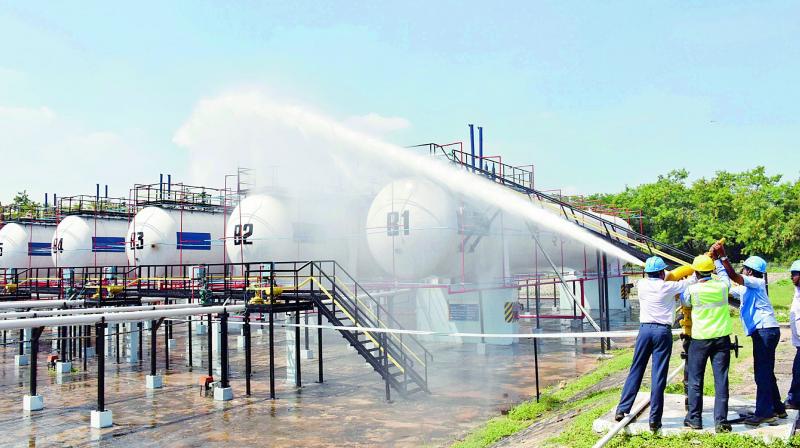Not isolating Cherlapally LPG plants can be risky
The danger is that an accidental leak could happen anywhere — from any of the tanks at the tank farm or even from a tanker truck.

Hyderabad: The danger of having massive LPG storage plants near cities and human habitations in Telangana state is being grossly underestimated, according to an environmental engineer.
Thousands of tonnes of highly-inflammable liquid gas petroleum stored at Cherlapally, near Secunderabad, could cause unimaginable loss to life and property in case of an accidental release.
Sagar Dhara, an environmental engineer who specialises in risk analysis, said a disaster could be waiting to happen unless the plants are moved to isolated areas.
The industrial zone of Cherlapally, an area packed with industrial establishments and manufacturing units, has three massive LPG storage plants owned by Indian Oil Corporation (IOC), Bharat Petroleum Corporation Limited (BPCL) and Hindustan Petroleum Corporation Limited (HPCL).
The companies have other plants in Telangana state, including one at Thimmapur in Mahbubnagar district and another at Jammikunta in Karimnagar district.
The IOC’s Rated Bottling Capacity at its Cherlapally plant is 180 TMTPA (thousand metric tonnes per annum), and a massive 50,000 cylinders are bottled here per day.
Its plant in Thimmapur has a capacity of 120 tmpta and bottles 35,000 cylinders every day, a spokesperson from the company confirmed.
BPCL’s Cherlapally plant has a capacity of 170 tmt per annum, producing 40,000 cylinders per day, and HPCL has the capacity to produce 218 tmt per annum at its Cherlapally plant, according to a 2017 report.
An accidental release of LPG is likely to affect everything within a radius of three-and-a-half km surrounding the plants, Mr Dhara said.
For Cherlapally, this could mean affecting thousands of people, many schools, hospitals and places of worship, and reaching dangerously close to the Nuclear Fuel Complex in Moula Ali.
The loss would be “devastating”, said Mr Dhara, and added, “LPG accidents are a huge risk and happen every year in India.”
The danger is that an accidental leak could happen anywhere — from any of the tanks at the tank farm or even from a tanker truck.
Mr Dhara, who submitted a risk appraisal of IOC’s proposed LPG tank farm at Puduvypin in Kochi to the villagers of Puduvypin, added, “The boiling liquid expanding vapour explosion that happened in an LPG tank farm in a suburb of Mexico City in November 1984, killed about 800 people.”
Usually, LPG is shipped as a cryogenic substance — in liquid form at very low temperatures. It is then loaded into pipelines and transported to storage tanks before being distributed through tanker trucks.
Mr Dhara added, “There are several risks involved in the entire process. For example, if the pipelines carrying petroleum products develop a leak, it could mean a massive fire or explosion.”
He added, “An LPG spill along a tanker transport route also poses high risk to humans and structures due to three consequent events — thermal radiation from a fireball or a pool fire, flying fragments and overpressure from the explosion, and downwind toxic effects of the fire by products.
“The only solution is to move them away from human habitation.”
Speaking about the safety measures in place, a spokesperson for IOCL said: “All plants are constructed in line with Oil Industry Safety Directorate (OISD) standards and comply with various statutory authorities like Petroleum and Explosives Safety (PESO), Factories Department, Central Electricity Authority (CEA) etc.
“Extensive safety measures have been adopted which includes automatic sprinkler system, gas detection system, vapour extraction system, emergency shutdown system, remote operated valves etc. The Cherlapally plant is located in an industrial estate and Thimmapur is located at the far end of Hyderabad.”

